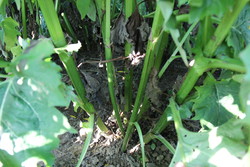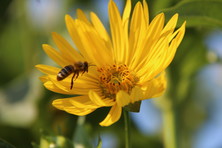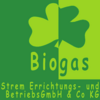Silphium perfoliatum L.

Silphium perfoliatum L. (Rosemary) is native to southeastern Canada and the eastern United States (NATURESERVE 2010). It was first brought to Europe, to the western USSR, in the 18th century.
Silphium perfoliatum L. belongs to the Asteraceae family and is a high-yielding, tall and perennial (perennial) C3 plant. In the first year of vegetation, only a rosette of twelve to fourteen leaves is formed. In the second year, the plants continue to grow as early as the beginning of April and numerous four-edged leafy stems are formed, reaching a length of up to three meters and completely covering the ground. About eight to ten flower baskets are formed per stem, which bloom bright yellow.
Nectar and pollen are used as food sources by many insects, wild and honey bees (DANIEL and ROMPF 1994, NEUMERKEL and MÄRTIN 1982). The plant does not have high demands on climate, soil and previous crop (CHRESTENSEN, 2010).
Raw material production
Stand establishment / crop management
Currently, planting with seedlings (four plants/m²) is recommended (CHRESTENSEN 2010). Direct seeding is currently not ready for practice due to various unsolved problems (low germination capacity of the seeds or low competitive strength of the seedlings, slow youth development, lack of seeding technology) (CONRAD et al. 2010).
In the first year, growth is very slow, so that weed regulation is necessary (mechanically or chemically, with registered preparations). From the second year on, weed control is usually no longer necessary. Disease and pest pressure is low according to current knowledge. Infestation by non-specific fungal pests (e.g. Sclerotinia) is possible in unfavorable years with larger acreages and depending on the previous crop.
Harvesting and processing
For biogas production, the crop is usually harvested towards the end of flowering and at the beginning of seed ripening (about the beginning to the end of September, dry matter content about 25% to 30%) harvested with a conventional rowless forage harvester and then ensiled.
Potential of the raw material
Yield potential
Economic yields are obtained from the second year of vegetation. Yield data vary widely. According to DANIEL and ROMPF 1994, Silphium perfoliatum L. yields from 16 t DM/ha to 27.4 t DM/ha at the bud stage (early June). After flowering, yields of 27.4 t DM/ha to 36.6 t DM/ha can be expected.
According to CHRESTENSEN 2010, the yield potential from the second year of cultivation is between 13 t DM/ha and 18 t DM/ha. NEUMERKEL and MÄRTIN 1982 arrived at a maximum DM yield of 19 t DM/ha (averaged over five years) in their trials.
CONRAD et al. 2010 determined a theoretical methane content of about 300 to 350 l/kg oTS [organic dry matter] and a methane content in biogas of about 57%. Depending on the DM yield per hectare, this results in a methane yield between 6000 to 8000 m³/ha/a-1.
Ecological potential / diversity of the cultivated landscape
In many areas, the landscape is very strongly characterized by the predominant cultivated plants, which makes the landscape look very monotonous and decreases the acceptance in society. Silphium perfoliatum L. could therefore represent an important landscape element with its yellow, attractive flowers and break up the cultivated landscape. An expansion of the crop spectrum by Silphium perfoliatum L. would furthermore represent significant benefits for biodiversity, soil sustainability, groundwater protection and for the reduction of soil erosion. Cultivation of this perennial crop adds a quantity of crop and root residues to the soil, and the soil dormancy that exists during its many years of use leads to humus accumulation (VDLUFA, 2004). Crop protection agent use is also reduced.
Additionally, the cultivation of Silphium perfoliatum L. would result in a substantial expansion and enrichment of the pollen and nectar supply in midsummer and late summer and would improve the food base for honey bees, wild bees, and other flower-visiting insects. Providing an abundant food source and nesting opportunity throughout the growing season is very important for maintaining a species-rich fauna (WESTRICH, 1990; BANASZAK, 1996; STEFFAN-DEWENTER and SCHIELE, 2008). A wild bee and honey bee fauna rich in species and individuals also ensures pollination of various cultivated and wild plants (LASALLE and GAULD, 1993; WILLIAMS, 1996) and thus promotes yield security in agriculture, as well as the maintenance of a species-rich flora of flowering plants.

Literature
BANASZAK J (1996) Ecological bases of conservation of wild bees. In: MATHESON A, BUCHMANN S L, O’TOOLE C, WESTRICH P, WILLIAMS I H (eds) The Conservation of Bees. Academic Press, London: 55-62.
CHRESTENSEN, N. L. (2010): Durchwachsene Silphie (Silphium perfoliatum). Broschüre. Erfurt: Chrestensen.
DANIEL, P. und ROMPF, R. (1994): Possibilities and limits in the utilisation of Silphium perfoliatum as a fodder plant, renewable raw material and a landscape conservatio-plant. Agribiological research – Zeitschrift für Agrarbiologie Agrikulturchemie Ökologie 47. 345-353.
KOVACS, P. (2008): Ways of achieving competitive gaseous transportation fuel (biomethane) production through anaerobic fermentation of selected energy plants grown in Hungary. Wien: Master Thesis an der Technischen Universität Wien.
LASALLE, J. und GAULD, I.D. (1993): Hymenoptera: their diversity, and their impact on the diversity of other organisms. In: LASALLE, J. und GAULD, I.D. (s.a.): Hymenoptera and biodiversity. CAB International, Oxon, New York, 1-26.
NATURESERVE (2010): Silphium perfoliatum L. [URL: www.natureserve.org/explorer/servlet/NatureServe] (01.02.2011).
NEUMERKEL, W. und MÄRTIN, B. (1982): Die Durchwachsene Silphie (Silphium perfoliatum L.) – eine neue Futterpflanze. Archiv für Acker- und Pflanzenbau und Bodenkunde 26. 261- 271.
SOKOLOV, V.S. und GRITSAK, Z.I. (1972): Silphium – a valuable fodder and nectariferous crop. World Crops 24 (6). 299 – 301.
SONTHEIMER, A. (2007): Alternativen lassen hoffen. Biogas Journal 3. 42-45.
STANFORD, G. (1990): Silphium perfoliatum (cup-plant) – as a new forage. Proceedings of the Twelfth North American Prairie Conference. 33-38.
STEFFAN-DEWENTER, I. und SCHIELE, S. (2008): Do Resources or natural enemies drive bee population dynamics in fragmented habitats? Ecology 89(5), 1375-1387.
WESTRICH, P. (1989): Die Wildbienen Baden-Württembergs. Stuttgart: Ulmer Verlag.
WILLIAMS, H.W. (1996): Aspects of bee diversity and crop pollination in the European Union. In: MATHESON, A.; BUCHMANN, S.L.; O´TOLLE, C.; WESTRICH, P. und WILLIAMS, I.H. (s.a.): The conservation of Bees. London: Academic Press. 63-80.
Bioenergy-Silphium" research project

Increase of biomass production by Silphium perfoliatum L. for energy recovery in Austria.
Silphium perfoliatum L. is a possible alternative to the previously dominant energy crops. Its potential is being explored under Austrian conditions in the Bioenergy-Silphium project.
Project background
Due to the energy policy of the European Community, the production of energy from renewable raw materials is gaining importance and leads to the expansion of the cultivation areas of dominant energy crops. The consequences are increased pest and disease infestation and increased environmental pollution. The forced decrease of land for food and feed production leads to tensions in the food market. To minimize this, alternatives are needed.
Silphium perfoliatum L. could be such an alternative, as it is a high-yielding, perennial, undemanding plant that can also be cultivated on non-farmland (fallow land, communal land, former spoil or landfill sites, etc.) and erosion-prone land (including slopes). This would increase the land available for biomass feedstock production without limiting the land available for fodder and food production.
Project short description
To date, there are no scientifically sound results from cultivation trials of Silphium perfoliatum L. under Austrian climatic conditions. Based on the results of the Thuringian State Institute for Agriculture, the Bioenergy-Silphium project has designed solutions to increasingly exploit the potentials in terms of biomass and energy yields. At the same time, the goal of minimizing soil loss (erosion), the pollution of ground and surface waters by nutrient input and pesticides, as well as emission pollution is being pursued.
Project data
Research topic: Sustainable plant production Acronym: Bioenergy-Silphium Project duration: 04/2012 - 03/2016 Project management: Dr. Josef Mayr, AGES Funding body/research program: Climate and Energy Fund (FFG) / New Energies - 5th call for proposals.
This project is funded by the Climate and Energy Fund and is carried out within the framework of the program "NEW ENERGIES 2020".


Project partner
- Austrian Agency for Health and Food Safety GmbH
- University of Natural Resources and Applied Life Sciences Vienna
- Biogas Strem Errichtungs- und Betriebs GmbH


The "Bioenergy-Silphium" project team

Project goals
The central objective of the project "Bioenergy-Silphium" is to increase bioenergy production by using Silphium perfoliatum L. to increase the biomass sustainably available in Austria for energy utilization without restricting the existing areas for food or feed production.
Consequently, the following project objectives were derived:
- Establishment of the stand by planting in three climatic zones favorable for arable farming and in a marginal yield position of arable farming, as well as the development of a high-quality seed for a time- and cost-saving stand establishment with commercially available sowing machines.
- Determination of the biomass potential on the different sites and with different harvest variants
- Determination of the energy potential of the produced biomass (biogas, thermal energy, ethanol)
- Investigation of selected environmentally relevant factors such as CO2 emission, erosion stability, input of nitrate and dissolved substances into surface waters as well as into seepage and groundwater
- Economic evaluation of biomass production data of S. perfoliatum in comparison with other energy crops.
Apart from increased biomass production and non-competition with land needed for food security, other environmental and socio-political benefits include:
- Reduction of soil erosion (erosion control).
- Improvement of water storage capacity
- Promotion of humus formation through soil dormancy
- reduction of the risk of groundwater and emission pollution due to year-round soil cover and soil dormancy
- reduced use of pesticides due to low disease and pest pressure and weed suppressing properties
- increase of biodiversity (refuge for insects, bee pasture)
- enhancement of the landscape due to the long flowering period with its yellow, attractive blossoms
Results
Detailed information on the project results is also available in the downloads at the bottom of this page. Publications on this topic can be found in our publication database.
Stand establishment (planting/seeding technology)
The obstacle of labor- and cost-intensive stand establishment by planting could be significantly reduced with the development of seed technology. Seed quality has been improved through targeted processing of harvested seed, and field emergence and seedability have been increased through pretreatment and pelleting, so that in the future it will be possible to sow with a conventional seed drill to achieve satisfactory field emergence.
Stand management
Up to five mechanical weed treatments are required for optimum stands. If weed control is insufficient in the planting year, it must be repeated accordingly in the following spring. From today's point of view, no economic damage due to plant pests and pathogens is to be expected, since the frequency of infestation is very low and harvesting the whole plant significantly reduces the inoculum potential. Therefore, if weed control is successful in the planting year, further crop management measures are limited only to fertilization.
Biomass yield potential
The biomass yields in the crop years (from the second year of vegetation onwards) varied from site to site and ranged between 7.88 and 24.94 t DM ha-1 year-1. The highest biomass yields were measured at the favorable sites Grabenegg and Schönfeld. The values collected were comparable to the maize yields determined at the same site. Hirschstetten and Strem achieved lower biomass yields due to the location. This can be attributed to the prevailing insufficient water supply on these soils. The strongly increased soil penetration resistance in the upper soil layers (0 - 15 cm) in spring at these sites may have had an additional influence on yield.
The yields of the two-cut variants were higher than those of the single-cut variants, with the exception of the Grabenegg site in 2013. The single-cut variant appears to be more feasible, since at that time the crop has a higher dry matter content than the two-cut variant and allows for better ensiling. In addition, the ecological benefits (bee grazing, erosion reduction, etc.) of S. perfoliatum can be used for a longer period of time.
Energy recovery
On sites with high biomass yields (Grabenegg, Schönfeld) and when the optimal harvest time is chosen, the methane yield per hectare approaches that of corn. Processing into bioethanol is not recommended because the yield is 64% lower than for corn straw. Thermal-energetic utilization is to be rejected due to the high ash content, as well as the relatively high nitrogen, sulfur and chlorine content values in the harvested material.
Evaluation of selected environmental parameters
Particularly noteworthy are the environmentally relevant advantages of S. perfoliatum stands, such as the significantly low risk of erosion in the crop years, the possibility of cultivation without chemical pesticides, the rapid uptake of nitrogen and thus prevented leaching into ground and surface waters, the tendency of CO2 binding in the soil, the increase in biodiversity as a result of the additional alternative crop, and the attractiveness of the flowers for honey bees over the long flowering period of 2.5 months.
Economic utilization
The contribution margins of corn are currently higher than those of S. perfoliatum in terms of biogas production. The reasons are the high costs of establishing S. perfoliatum by planting. To be competitive with corn, stand establishment costs must be reduced by up to 50% depending on location. Stand establishment by seeding achieves this goal.
Last updated: 10.10.2023
automatically translated